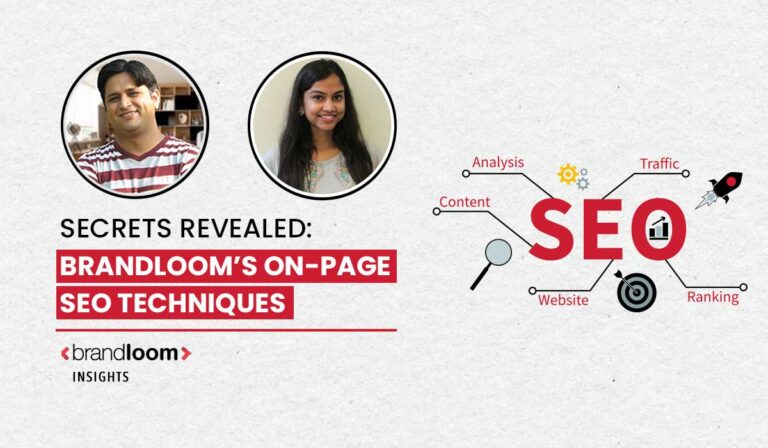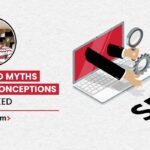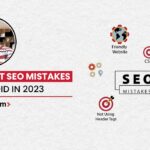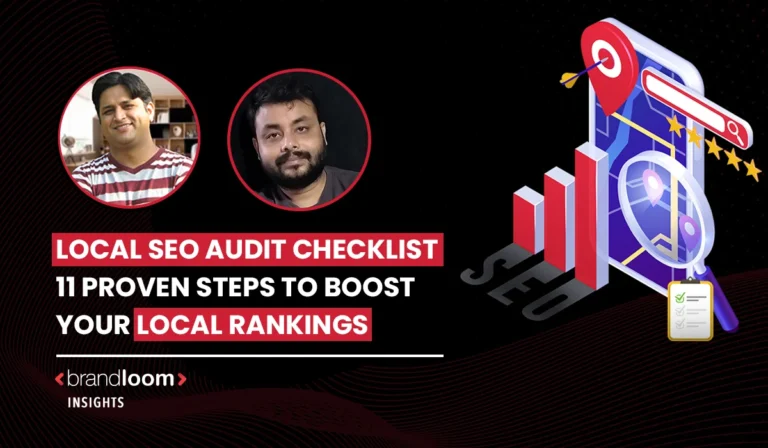Good content keeps people engaged, but what do you do to bring your target audience to your page? That’s when on-page SEO techniques help you rank in search engines just when people are looking for answers.
There are a number of things beyond just quality write-up, like On-page SEO, Off-page SEO, mobile-friendliness, etc., to help rank your blog.
Among all, On-page SEO is the most important tactic to rank your page. It is responsible for getting visibility in organic search results.
A website is the representation of the brand. Hence proper SEO techniques must be implemented for users and search engines. If not done properly, you might be taking away the opportunity for your target audience to see what you offer.
This post will tell you everything you need to know about on-page SEO Techniques deployed by SEO Services Team at BrandLoom, which will help you improve your search engine rankings. BrandLoom has been consistently ranked as the best SEO company in India.
Ensure you read the blog until the end to learn the best on-page techniques for your business.
Looking for SEO Services Agency in Delhi, Contact us now!
What is On-Page SEO?
Sites compete to get that first spot in the search results. When millions of pages are talking about the same thing, answering the same questions, what makes one page so different that it wins that sweet first rank? The answer is- SEO.
To begin with, SEO is how you talk to google bots; make them understand why your content is the best and why it needs to be ranked. And there are several ways to do that. That being said, On-page SEO is the most important and primary SEO technique that is a must.
The on-page SEO techniques are a way to optimize your page, which helps search engines understand how beneficial and relevant you are to your target audience.
These steps help search engine crawlers understand the context of your pages. On-page SEO is also referred to as onsite SEO as a way to optimize the content on your website pages for better ranking.
Looking for SEO Services Agency in Mumbai, contact us now!
Why is On-Page SEO Optimization important?
On-page SEO helps Google bots understand and index your content. Without good on-page SEO, the crawlers might never understand the intent of your content and hence might not even rank it for your target audience.
During indexing and ranking, search engines usually associate keywords and search terms with web pages.
These On-Page SEO elements guide the search engine to understand that your content is relevant to the search term and helps you acquire a position at the top.
Also, any optimization elements done on the web pages improve user experience.
For example, one important factor in on-page SEO is keywords.
Consider someone searching for ‘Orange juice’ on google. Now, what is the intent? Does the person want to drink orange juice? Does he want to know the best place to sell the orange juice? Or does he want to make one at home?
Since you can never know, you need to incorporate all the related topics associated with the search term ‘orange juice’ to have the most chances of ranking. Also, you need to add content based on related keywords that people might be searching for.
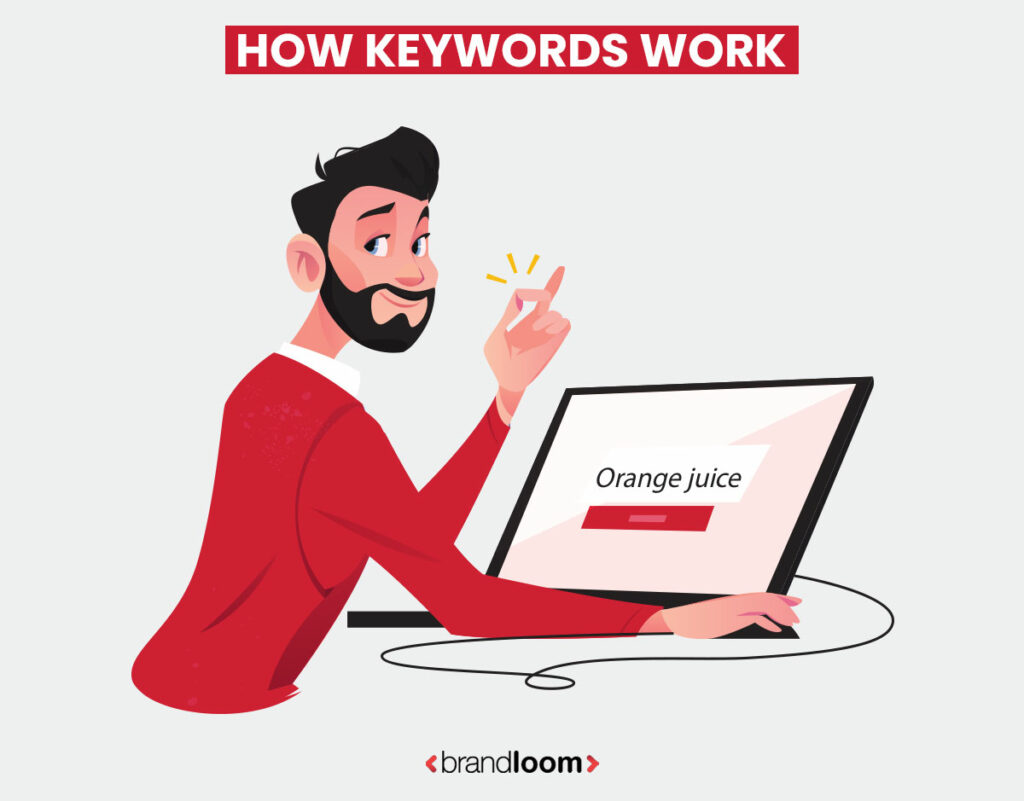
It not only helps you rank for your main topic but also gives you the opportunity to rank for related topics that people might be searching for. For example, with proper On-Page SEO, your site can also rank for related keywords, such as ‘best way to make tastier orange juice’, ‘best brand for healthy orange juice’ etc. Related keywords will help you broaden your topic and get more opportunities to rank.
Now let’s look at the popular on-page SEO techniques that should be implemented immediately.
Top 15 On-Page SEO Techniques That BrandLoom Implements
Talking about the more practical part, here are some on-page SEO techniques that our team at BrandLoom follows to achieve higher rankings on search engines.
- Compelling titles
- URL optimization
- Meta description
- Organized Headings
- Search intent
- Content formatting
- Image optimization
- Core web vitals
- Mobile-friendliness
- Internal Linking
- External linking
- Content Audit
- Sitemap
- Protocols HTTP and HTTPS
- Comments
There are definitely more on-page SEO techniques than we mentioned above, but these are the most prominent ones that should be implemented today to boost your SEO efforts.
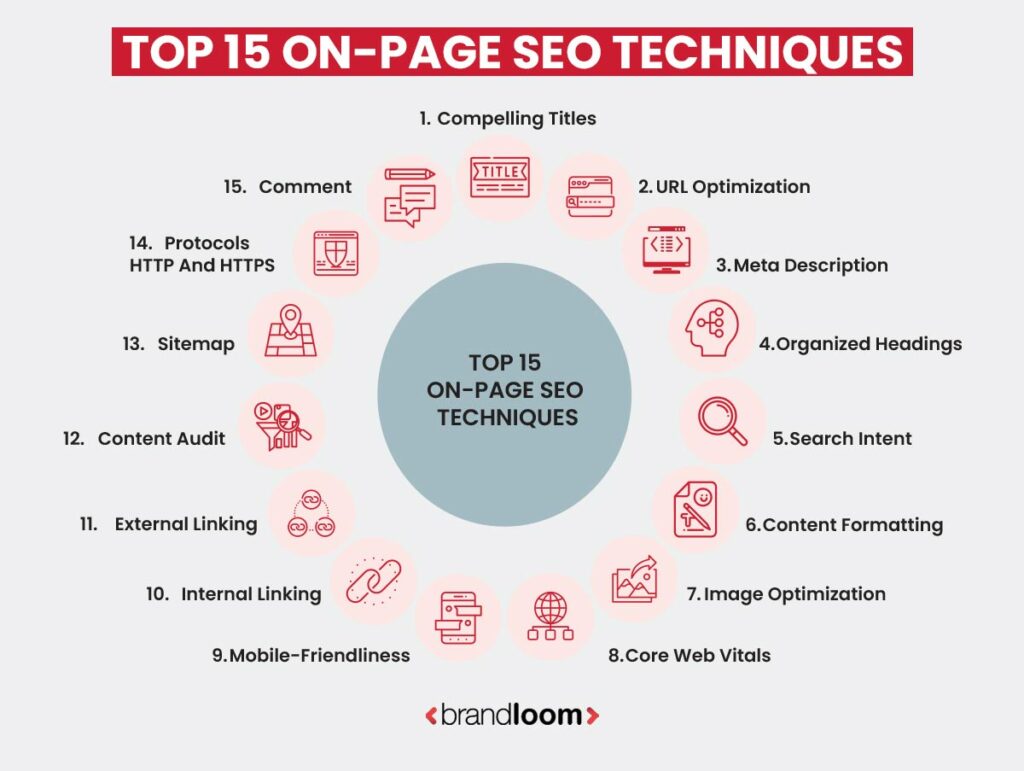
1. Compelling Titles for On-Page SEO
Every page on the website comes with a unique title.
It is the first thing your target audience sees in the search results, and it’s a great opportunity to draw users’ attention to your website. You can check how your title appears in the search results whenever someone searches for a ranking keyword.
If you have a title tag that is very compelling and persuasive enough, you will be able to get visitors to your website then and there.
Here are some simple rules to make your title tag impressive-
- Keyword usage: Use a target keyword that helps the user and the search engine understand the context.
- Place your keyword at the front of the title tag as it can help it rank better and users read them first.
- Length: Search engines can only show the first 50-60 characters. If the title exceeds the character limit, it is truncated, and the rest of it will be shown as an ellipsis “….”
- Branding: Try to enter your title tag with your brand name. It will create some visibility and improve the click-through rate if you already have some brand awareness among your target audience.
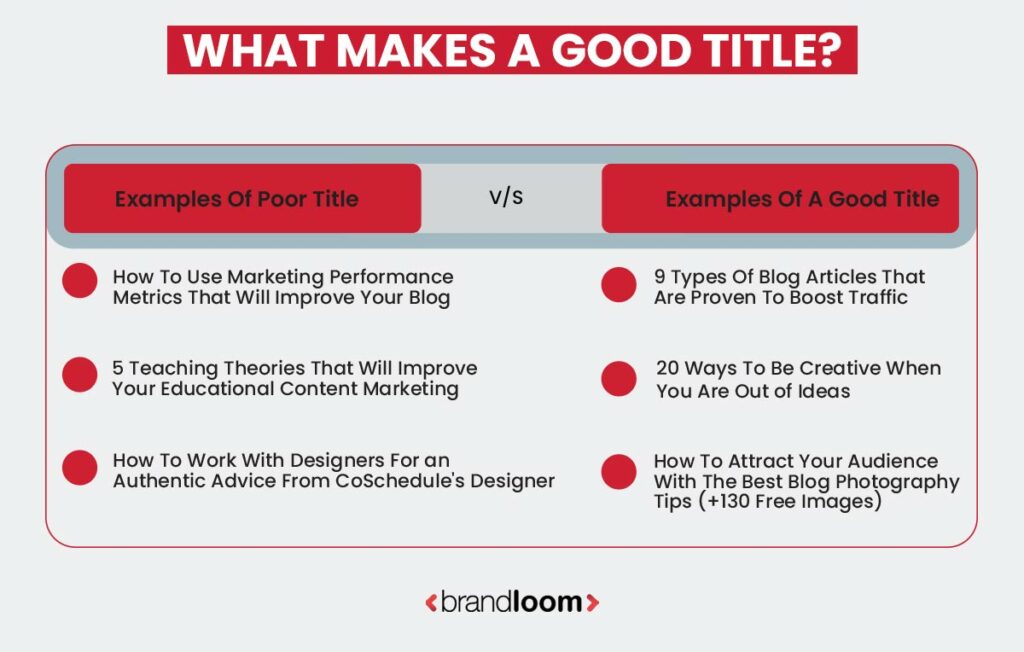
What makes a good title?
Example of poor title
- Improve Your Blog with Marketing Performance Metrics
- Teaching Theories That Will Improve Your Educational Content Marketing
- How To Work With Designers
Example of a good title
- 9 Types Of Blog Articles That Are Proven To Boost Traffic
- 20 Ways To Be Creative When You Are Out of Ideas
- How To Attract Your Audience With The Best Blog Photography Tips (+130 Free Images)
As we can see, good ones have a kick in them. They are easy to read, seem trustworthy, are backed by data or resources, and do not have any filler words.
They are very straight to the point and effective. Whereas bad ones are unnecessarily lengthy, complex to read comparatively, and offer no data or proof of how this blog will help the readers.
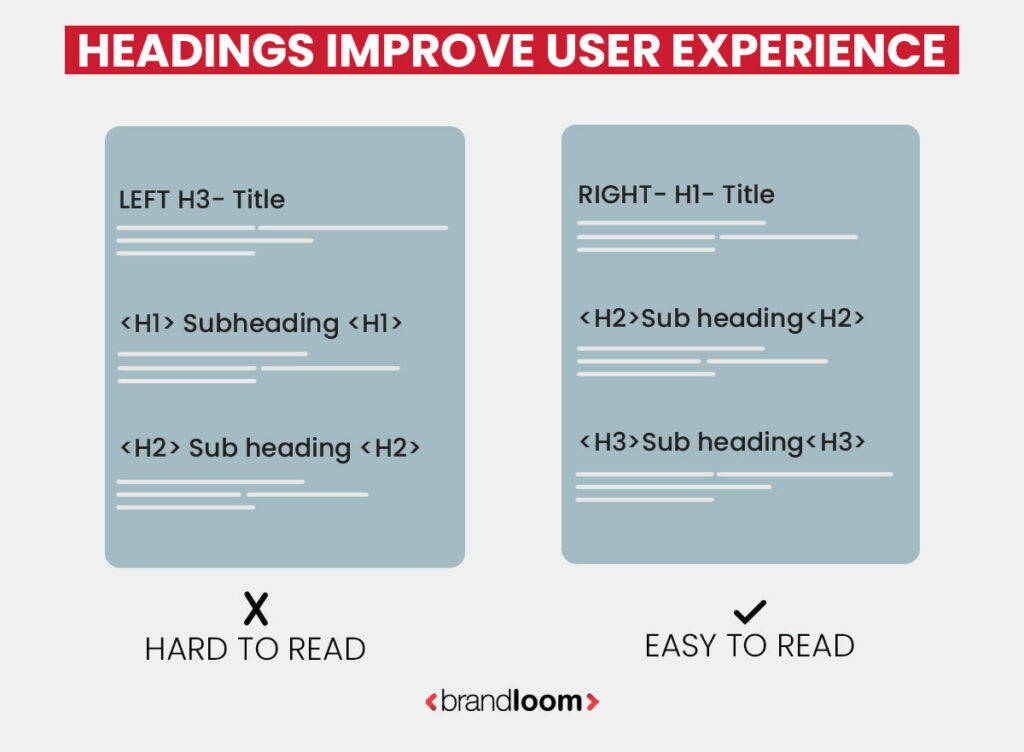
2. URL Optimization: On-page SEO techniques
URL is the unique address of every web page on the internet. The format and the wording of your URL affect The click-through rate. As per On-Page SEO, the most important aspects of URL optimization are naming, URL length, and structure.
Clear Page Naming
Always name the URL relevant to the context of your web. It should help readers and Google search engines understand what the URL and its page are about.
Look at the two examples given below and see which one makes more sense in terms of intent-
example.com/men/t-shirts
or
example.com/xyx/adf?ts-132-23
People will most likely go to the first website as it provides them clarity and the context of what is there on the page.
URL is a minor ranking signal by search engines.
The recent EMD update of Google about low-quality, exact-match domains says that it’s not certain that you will rank for a keyword even if you own the same domain name- the quality of content on your web page needs to be relevant and effective.
URL Structure
A good URL structure should simplify the categories and topics for the readers.
Such as-
example.com/seo/on-page-SEO vs. example.com/on-page-SEO
Also, remember that you should not date your content; otherwise, it creates an impression that it’s not evergreen and is only needed for a particular time mentioned.
For example:
example.com/may/2020/what-is-SEO vs. example.com/what-is-SEO
Also, make sure you arrange the pages in appropriate folders to help search engines understand the hierarchy of content on the site.
URL Length
Users prefer shorter URLs because it’s easy to read and remember. However, remember that you should make your topic clear in the URL, even if it gets a little longer
For example-
example.com/what-is-SEO vs. example.com/seo
The example of ‘what SEO is’ gives a much better context of what the page is about rather than just the SEO one.
3. Optimize Meta Descriptions
Just as title tags tell what content is, meta descriptions tell a short summary of the page content. It is nested in the head tag-
<head> <meta name=” description” content=” Description of the page here.”/></head>
For instance, if you search ‘blogging’ on Google, you will see a description below the topic, which is about what you will read if you click on this link.
However, your meta description will differ from what Google will display. Search engines always try to improve the description based on the searches.
Still, it would help if you wrote a compelling meta description as a brief of what your blog is about. Remember the few points mentioned below to craft a perfect meta description.
- Relevance: Your meta description must be relevant to the page content. It should crisply summarize the content.
- Length: Meta descriptions are around 150-300 characters. Search engines truncate meta descriptions exceeding 155 characters.
4. Organized Headers: On-Site SEO Techniques
Heading tags denote the actual heading on your page that a visitor sees when he comes to the web page. The header tag is H1, which is the page’s topic.
Each page on your website needs to have a unique H1 tag. Make sure all the headings have the target keyword for which the page aims to rank.
Other than H1, there are different heading tags, such as H2, H3, and H4, which are further used in the content when required.
Heading tags should not be used to mark non-heading elements such as phone numbers or navigational buttons. These should only be used to set the context and introduce users to the topic.
Here’s how you can create an effective heading tag-
- Don’t write heading tags in just a single word. Make it interesting, brief as per the character limit, and informative for the users.
- Avoid using the same heading tags more than once.
- Follow the appropriate hierarchy from H1 to H6 to display the information.
- Insert related keywords and phrases in subheadings.
5. Match Search Intent with the Content
Search intent simply means the purpose of the search.
There can be many reasons for looking up something on google. What does the user want to know?
Does he want to know a recipe to cook dinner, or does he want to purchase something online? Google figures that out and puts out the best pages in the search results that match our search intent.
Google has now become very efficient in determining the users’ search intent. Search intent is so important that they often outlet classic factors such as link-building headings and other SEO basics.
Search intent is divided into these broad categories:
Navigational: The user intent is to reach a particular site.
For Example- A navigational query is a search to find a specific website. For example, the search query “Twitter” is navigational because the intent is to access Twitter.
Informational: The purpose is to get information present on a specific page.
For example- when the user wants to get some information to solve his query- such as ‘how green tea helps with eight loss’. Here the user’s search intent is to hope to find answers.
Transactional Search Intent: The goal is to purchase or spot a product/service for future purchases.
For Example- when the user wants to buy a product at the moment. It can be like ‘Cheapest Adidas shoes for young men’. Here the intent is to know about the price and hopefully make a purchase.
With time, search engines understood that this categorization was too broad and overlapping. Hence, to ensure that the website ranks well and accurately for search terms, you need to create relevant content according to how your users search for it.
These are popular intents-
- Research Intent: this includes the keywords that show information content such as Wikipedia pages, featured snippets, carousEl, knowledge graph
- Answer Intent: here, the user is looking for a quick answer to his query. For example – How is the economy in America today?
- Transactional Intent: here, the user wants to buy or research a product. The search results often come with e-commerce website shopping boxes with purchase intent features.
- Local Intent: this is when people are searching for something in a specific locality. Here, Google searches for the IP address that the user is in, especially for searches that include ‘near me.
- Visual Intent: this means the user is looking for the visual search of something which can be imaged. Google shows similar platforms that can offer the real such as Pinterest. Video Intent includes phrases or keywords related to video carousals, thumbnails, or video featured snippets.
6. Content Formatting for On-Page SEO
Formatting greatly improves the readability of your content on the page. It is not about what is written but how you present it; you always have to improve the user experience while reading the content. And you can do that by following these on-page SEO tips-
How to format content?
- Readable Font and colour scheme: according to Google, 16-point font and above should be used to minimize the need for pinching and zooming, especially for mobile users. Also, the font colours should enhance the readability.
- Organised Headers: proper subheadings should be there to make the content flow logically. Also, anchor links should be used so that users can skip to important sections.
- Bullet Points and Lists: listicles are always easier to read, skim through, and quickly get the content that users are looking for.
- Smaller Paragraphs: break your content into optimal sections or four or five lines to enhance readability.
- Supporting Media: including media such as videos or images help complement your content and make it look much more interesting to the readers.
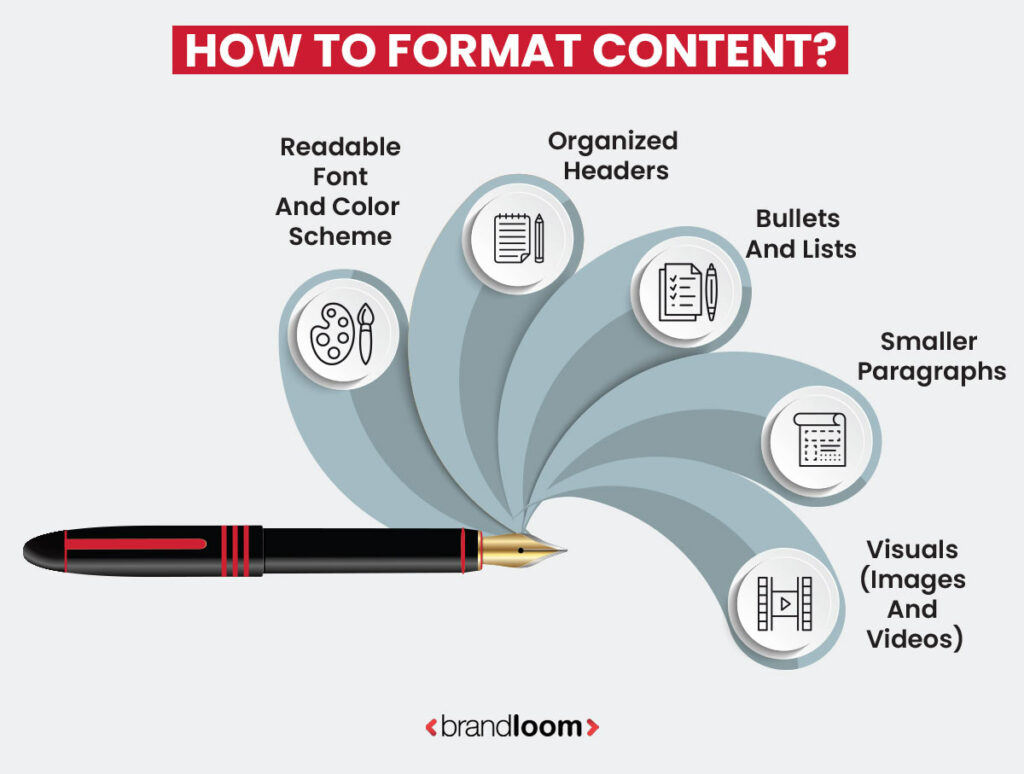
7. Image Optimization for On-Page SEO
Images can be very attractive to readers, especially in long-form content.
Not only do they help in ranking factors but also in keeping the readers engaged throughout the range.
The alternative text (alt text) helps search engines understand our photos. With the use of the right keyword in the alt text, the blog gets an opportunity to rank once again with the help of these photos. Alt text should be about the keyword but also the context of the image and the blog.
<img src=”grumpycat.gif” alt=” A black cat looking very grumpy at a big spotted dog”>
However, it would help if you remembered that images are one of the major factors in slowing down your website.
Make sure you compress your photos before you upload them. Many tools, such as ‘compressnow’, can effectively shorten your picture in a way that doesn’t affect the page load time.
You can also opt for lazy loading techniques to load images quickly on the website. You should submit the image sitemap from your Google search account if you have many images on your page.
Needless to say, that Image Optimization is critical for SEO success.
8. Core Web Vitals
Even after a lot of effort by Google, accelerated mobile pages have not helped the website improve speed on mobile. Among two billion websites that use amp, just 0.1% benefit from the study conducted by W3Techs.
Google measures user experience on the web with the help of core web vitals and optimizes sites for top stories which don’t use AMP. Optimizing your site for core web vitals is an integral part of on-page SEO, as it is one of the major factors for the drop in ranks.
9. Mobile Friendliness for On-Site SEO
Most of the traffic businesses get today is from mobile users in many countries. You can check how mobile-friendly your website is with the help of the Google Mobile-Friendly Test.
Also, you can check your mobile usability in the Google search console and fix any related issues. Make sure all the plugins on your websites are mobile-friendly.
Our Website Maintenance Team at BrandLoom Consulting can help you manage your mobile friendliness issues. We are efficient in implementing trending technologies that drastically affect website mobile-friendliness.
The reason is we are always alert to the changes in the world of digital marketing. We know what will impact the brands in what way; hence we can implement the best tactics before it worsens. If you are struggling to make your business mobile-friendly, call us.
10. Internal Linking
Internal linking is when your page links to another page on the same website. This enables search crawlers to find other pages bringing them more visibility and traffic. It also helps to pass the link equity across other important pages.
A typical internal linking structure looks like a pyramid. It helps you pass the link equity through the whole website, increasing the ranking potential for all pages.
11. External Linking
Like internal linking, external linking means linking to other authoritative websites to create trust in your content. Adding external links to your website can sound a bit counteractive, but it helps you build authority when you link it to a huge relevant webpage in the same niche. It is one of the critical and popular on-page SEO techniques.
12. Content Audit
Content audit lets you determine which parts of the content must be retained, deleted, or repurposed from the website.
Considering the quantitative and qualitative parameters on what’s working to help page rank today, you should always do a content audit of your web pages on a timely basis and update them likewise.
Quantitative measures evaluate the content outcomes, including the overall impact on traffic and rankings- metrics like traffic on the page in the last 30 days or average SERP position.
Qualitative parameters are about the quality of content, such as- How many visitors read the piece? Do they engage with the content?
Keep the evaluation simple to make sure that you audit faster. Do this every 3-6 months to ensure you constantly filter your content strategy.
13. Sitemaps
Submitting sitemaps is crucial to getting your page indexed. They make the webmaster aware of the pages on your website that need to be crawled. A site map is an XML file with a list of URLs and additional metadata for a site.
Sitemaps let web crawlers identify and crawl the pages of your site. They also give other necessary information, such as the page’s last update and how frequently it is modified.
14. Protocols HTTP and HTTPS
The most confusing thing is determining whether “HTTP” or “HTTPS” is best for your domain name. Google recommends having a secure protocol, which means HTTPS, as the ‘s’ stands for secure. Also, to ensure your website is safe, you need an SSL certificate from the hosting provider.
It encrypts your data and ensures the data passed between the search browser and the web server remains private. HTTP also helps improve loading time and efficiency.
15. Comments
We often disable comments on the website, thinking all we’ll get is spam. However, a few advantages to having blog comments boost SEO.
Comments help in getting traffic through latent semantic indexing keywords. These keywords are related to the main keywords and help your blog post rank for more than the focus keyword. If search engine crawlers see a lot of text below the post, they use that as an indication to rank your article higher.
Conclusion: On-Page SEO Techniques
These were the most important on-page technique to implement on your website. However, there is more to it, and you can get the hidden secrets of on-page SEO from an experienced SEO services agency like BrandLoom. Give us a call for a consultation.
Let’s wrap it up with a quick checklist summarising the key points.
On-page SEO checklist
- Make sure your content is unique, original, well-researched, and resonates with the user’s search intent.
- Use the focus keyword or phrase in the heading, title, meta, alt text, and body content.
- Make sure your website is mobile-friendly and follows the guidelines of search engines.
- Optimize your page title, URL, and meta description, to make the first impression on your website and improve the click-through rate.
- Add enough internal and external links to each page.
- Provide clear page names in the URL and structure it to enhance readability.
- Check the website’s core web vitals and ensure it loads within 2.5 seconds.
- Secure your website with an SSL certificate.
- Heading tags should be in chronological order from H1 to H6.
- Perform a quarterly/half-yearly content audit to add necessary elements and delete outdated pieces.
Frequently Asked Questions
What are on-page and off-page SEO techniques?
On-page SEO is the practice of optimizing web pages to improve the search engine ranking of a website. It is the most important step in gaining organic traffic. Besides publishing relevant content, the website needs high-quality content with updated on-page SEO techniques that optimize content, title, meta, header, and images.
Off-page SEO techniques include getting links from external websites to enhance the SEO strategy. It is basically any activity that happens outside of your website that helps improve the position of your blog. It can include guest blogging or social media marketing as well.What is an on-page SEO example?
On the page, SEO means optimizing the front and back components of the website so it can get better rankings. On-page SEO’s primary features include site architecture, HTML, and content elements.
The easiest example of a page SEO technique is inserting keywords in your content at appropriate places. Making your content keyword rich is the most prominent part of all page SEO, including other basic methods such as images, alt texts, internal linking, etc.What is the first step for on-page SEO?
The first step of one-page SEO begins with a clear picture of what kind of content you want for your target audience. Have a structure in your mind about the article’s flow; likewise, you need to implement SEO techniques on it.
Know which keywords you want to target and know who are the competitors you want to beat. Start building a keyword and content strategy that’s better than the rivals. Take inspiration to create strategies from the pages already ranking at the top.Why is SEO techniques on-page so important?
On-page SEO is a technique that helps Google bots understand your content. It helps them rank your article for your target audience by understanding its relevance to their needs.
Without a proper on-page SEO, keywords, and links, Google might not understand the right intent of your article. As a result, it might not rank your blog for your target audience as above as it deserves.
Hence on-page SEO is a must to help Google bots rank your blog.
Also, page SEO helps maintain the focus and relevancy of your blog for your target audience. It keeps them engaged throughout the content with the help of keywords.What are the types of SEO?
There are several types of SEO (Search Engine Optimization), which are techniques used to improve the ranking of a website in search engine results pages (SERPs). Here are some of the main types of SEO:
On-page SEO: This type of SEO focuses on optimizing individual web pages in order to rank higher and earn more relevant traffic in search engines. On-page SEO involves optimizing a web page’s content and HTML source code.
Off-page SEO: This type of SEO involves optimizing for factors that occur off the website’s page, such as backlinks from other websites. Off-page SEO helps improve a website’s credibility and authority, which can lead to higher rankings in search engine results.
Technical SEO: This type of SEO focuses on optimizing the technical aspects of a website, such as its infrastructure and server configuration, on ensuring that it is easily crawlable and indexable by search engines.
Local SEO: This type of SEO is designed to help businesses rank higher in search engine results for local searches. Local SEO involves optimizing a website for specific locations and includes techniques such as creating local citations and building local backlinks.
Mobile SEO: This type of SEO is focused on optimizing a website for mobile devices, ensuring that it is easily accessible and usable on small screens. Mobile SEO is increasingly important as more and more users access the internet from their smartphones.
Content SEO: This type of SEO involves optimizing a website’s content to make it more relevant and valuable to search engines and users. This can include optimizing the length, structure, and formatting of content and adding keywords and meta tags.
E-commerce SEO: This type of SEO is designed to help online stores rank higher in search engine results. It involves optimizing product pages, categories, and other e-commerce-specific elements to improve visibility and attract more relevant traffic.
Video SEO: This type of SEO involves optimizing videos to make them more visible in search engine results and on video-sharing websites such as YouTube. Video SEO can involve optimizing a video’s title, description, and tags and adding transcripts and closed captions.
Image SEO: This type of SEO involves optimizing images to make them more visible in search engine results and on image search websites. Image SEO can involve optimizing the file names and alt text of images and adding image sitemaps to a website.
Overall, SEO is a broad field that involves a range of techniques and strategies designed to improve the visibility and ranking of a website in search engine results. By implementing various techniques, businesses and websites can improve their online presence and attract more qualified traffic from search engines.What are the on-page SEO factors?
On-page SEO refers to optimising individual web pages to rank higher and earn more relevant traffic in search engines. Several on-page SEO factors can impact the ranking of a website in search engine results pages (SERPs).
Here are some of the main on-page SEO factors to consider:
Title tag: This is the title of a webpage as it appears in the search engine results page. The title tag should be unique, descriptive, and include relevant keywords.
Meta description: This is a short summary of a webpage that appears below the title tag in the search engine results page. The meta description should be descriptive, relevant, and include relevant keywords.
Headings: Headings help organise and structure a webpage’s content and should include relevant keywords.
URL structure: The URL of a webpage should be short, descriptive, and include relevant keywords.
Content: The content of a webpage should be relevant, well-written, and informative. It should include relevant keywords and provide value to the reader.
Images: Images should be optimized with descriptive file names and alt text that includes relevant keywords.
Internal linking: This involves linking to other pages within the same website. Internal linking helps to improve the navigation and usability of a website, as well as to distribute link equity.
Page speed: The speed at which webpage loads can impact its ranking in search engine results. Pages that load quickly tend to rank higher than slower-loading pages.
Mobile-friendliness: With more and more users accessing the internet from their smartphones, it is important for websites to be mobile-friendly. This means they should be easy to use and navigate on small screens.
Security: Websites that are secure (using HTTPS) tend to rank higher in search engine results.
Schema markup: This type of structured data can be added to a webpage to provide additional context to search engines about the page’s content. Using schema markup can help to improve the visibility and ranking of a webpage in search results.
Social signals: Social media activity, such as shares and likes, can impact the ranking of a webpage in search results.
By optimizing these on-page SEO factors, businesses can improve the ranking and visibility of their website in search engine results and attract more qualified traffic from search engines.What are the 4 types of SEO?
There are several types of SEO (Search Engine Optimization), which are techniques used to improve the ranking of a website in search engine results pages (SERPs). Here are four main types of SEO:
On-page SEO: This type of SEO focuses on optimizing individual web pages to rank higher and earn more relevant traffic in search engines. On-page SEO involves optimizing a web page’s content and HTML source code.
Off-page SEO: This type of SEO involves optimizing for factors that occur off the website’s page, such as backlinks from other websites. Off-page SEO helps improve a website’s credibility and authority, which can lead to higher rankings in search engine results.
Technical SEO: This type of SEO focuses on optimizing the technical aspects of a website, such as its infrastructure and server configuration, on ensuring that it is easily crawlable and indexable by search engines.
Local SEO: This type of SEO is designed to help businesses rank higher in search engine results for local searches. Local SEO involves optimizing a website for specific locations and includes techniques such as creating local citations and building local backlinks.
These are the four main types of SEO, but there are many other techniques and strategies that can be used as part of an SEO campaign.What are the 4 main techniques of off-page SEO?
Off-page SEO refers to techniques used to optimize a website for factors that occur outside of the website itself, such as backlinks from other websites. Here are four main techniques used in off-page SEO:
Link building involves acquiring links from other websites to your own website. Links are an important factor in the ranking algorithms of many search engines, and acquiring high-quality links can help improve a website’s visibility and credibility.
Social media marketing: This involves promoting a website or its content on social media platforms, such as Facebook, Twitter, and LinkedIn. Social media marketing can help to drive traffic to a website and to improve its visibility and credibility.
Influencer outreach: involves building relationships with influential people in a particular industry or niche and getting them to promote your website or its content.
Brand mentions: This involves getting your website or brand mentioned on other websites and online platforms, such as blogs, forums, and social media. Brand mentions can help to improve the visibility and credibility of a website.
By using these off-page SEO techniques, businesses can improve the ranking and visibility of their website in search engine results and attract more qualified traffic from search engines.What are the 3 C’s of SEO?
The “3 C’s” of SEO are often used to refer to the three main factors that can impact the ranking of a website in search engine results pages (SERPs): content, context, and crawlability.
Content: A website’s content is an important factor in its ranking in search results. Search engines look for high-quality, relevant, and informative content that provides value to the reader.
Context: The context in which a website appears in search results can also impact its ranking. This includes factors such as the user’s location and the website’s language.
Crawlability: The crawlability of a website refers to how easily search engines can access and index its content. Websites that are well-structured and have a clear hierarchy tend to be more crawlable, which can help to improve their ranking in search results.
By optimizing these three C’s, businesses can improve the ranking and visibility of their website in search engine results and attract more qualified traffic from search engines.What is the golden rule of SEO?
The golden rule of SEO is to focus on creating high-quality, relevant, and valuable content that provides value to the reader. This means creating content that addresses your target audience’s needs and interests and is informative, useful, and engaging.
In addition to creating high-quality content, it is important to ensure that your website is technically sound and easy to navigate. This includes having a clear hierarchy, using descriptive and relevant titles and headings, and using appropriate tags and metadata.
Overall, the golden rule of SEO is to create a valuable, useful, and relevant website for your target audience and provides a positive user experience. By following this rule, businesses can improve the ranking and visibility of their website in search engine results and attract more qualified traffic from search engines. So, the golden rule of SEO is to focus on creating high-quality, relevant, and valuable content that provides value to the reader.What is SEO Formula?
No specific “SEO formula” can guarantee a high ranking in search engine results. Search engine algorithms are complex and constantly evolving, and it is not possible to simply apply a formula to achieve a high ranking.
However, there are certainly best practices and strategies that can help to improve the ranking and visibility of a website in search results. These strategies typically involve optimizing both the on-page and off-page elements of a website and creating high-quality, relevant, and valuable content.
Some of the main factors to consider when optimizing a website for search engines include the following:
Title tags and meta descriptions: These should be descriptive, relevant, and include relevant keywords.
Headings: Headings should be descriptive and include relevant keywords.
URL structure: URLs should be short, descriptive, and include relevant keywords.
Content: A website’s content should be relevant, well-written, and informative. It should include relevant keywords and provide value to the reader.
Images: Images should be optimized with descriptive file names and alt text that includes relevant keywords.
Link building involves acquiring links from other websites to your own website. Links are an important factor in the ranking algorithms of many search engines, and acquiring high-quality links can help improve a website’s credibility and authority.
Social media marketing: This involves promoting a website or its content on social media platforms, such as Facebook, Twitter, and LinkedIn. Social media marketing can help to drive traffic to a website and to improve its visibility and credibility.
Technical SEO: This involves optimizing the technical aspects of a website, such as its infrastructure and server configuration, to ensure that it is easily crawlable and indexable by search engines.
Mobile-friendliness: With more and more users accessing the internet from their smartphones, it is important for websites to be mobile-friendly. This means they should be easy to use and navigate on small screens.
Security: Websites that are secure (using HTTPS) tend to rank higher in search engine results.
By implementing these strategies as part of an SEO campaign, businesses can improve the ranking and visibility of their website in search engine results and attract more qualified traffic from search engines.

